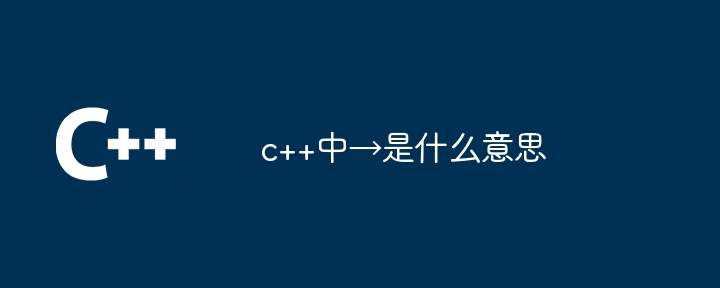Home >Backend Development >C++ >What does → mean in c++
What does → mean in c++
- 下次还敢Original
- 2024-04-28 17:39:151370browse
The arrow operator (->) in C is used to access object members. It combines a pointer and a member name to access the member. It is equivalent to the dot operator (.), but Requires objects to be accessed through pointers.

Arrow operator (->) in C
Arrow operator (-> ;) is an operator in C that is used to access object members. It is a point-to-member access operator that combines a pointer with a member name to access the member.
Syntax:
<code class="cpp">objectPtr->memberName;</code>
Where:
- ##objectPtr is a pointer to the object.
- memberName is the member name of the object.
Working principle:
The arrow operator is basically equivalent to the dot operator (.), but it requires that the object must be accessed through a pointer. It accesses members by implicitly dereferencing the object pointer.Example:
<code class="cpp">struct Point {
int x;
int y;
};
int main() {
Point p;
p.x = 10;
// 使用点运算符访问成员
std::cout << p.x << std::endl; // 输出 10
// 使用箭头运算符访问成员
Point *ptr = &p;
std::cout << ptr->x << std::endl; // 输出 10
}</code>
Advantages:
- Clarity: Use arrow operators Make it clear that the object is being accessed through a pointer.
- Flexibility: Allows access to members through pointers, which is useful in certain situations, such as when objects are stored in arrays or lists.
Note:
- Make sure the object pointer points to a valid object, otherwise the program will crash.
- If the object is not accessed through a pointer, the arrow operator cannot be used.
The above is the detailed content of What does → mean in c++. For more information, please follow other related articles on the PHP Chinese website!
Statement:
The content of this article is voluntarily contributed by netizens, and the copyright belongs to the original author. This site does not assume corresponding legal responsibility. If you find any content suspected of plagiarism or infringement, please contact admin@php.cn
Previous article:The impact of inline functions on performance: a deeper lookNext article:The impact of inline functions on performance: a deeper look

